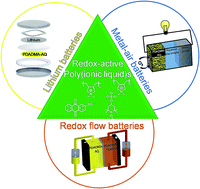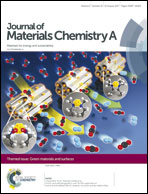Redox-active poly(ionic liquid)s as active materials for energy storage applications†
Abstract
New polymeric materials such as polymer electrolytes or redox polymers are actively being searched for in order to increase the performance and security of electrochemical energy storage devices such as batteries. Poly(ionic liquid)s are very popular materials in energy nowadays finding applications as ion conducting polymer electrolytes and electrode binders for batteries and supercapacitors. In this work, the incorporation of redox-active counter anions (anthraquinone and nitroxide molecules) into poly(ionic liquid)s has broadened the scope of applications as redox-active materials in different energy storage technologies. Polymers having those known redox-active molecules usually involve challenging synthetic routes and yield insoluble materials very difficult to handle. In this paper, we show that the synthesis of the redox-active poly(ionic liquid)s can be achieved through a straightforward and simple anion exchange reaction. We also show that this new family of redox-active poly(ionic liquid)s can be applied in several electrochemical energy storage technologies such as lithium batteries, as electrocatalysts in fuel cells and metal–air batteries or as electrolytes in organic redox flow batteries.

- This article is part of the themed collection: Green Materials and Surfaces


 Please wait while we load your content...
Please wait while we load your content...